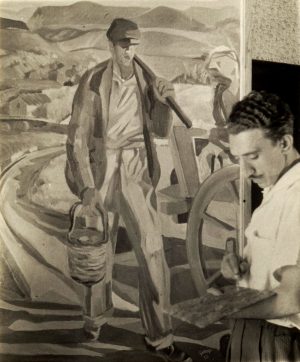LIFE

1918-1940
February 12, 1918, Nino Garajo was born in Bagheria from a bourgeois family with paternal ascendants of Spanish origin.
Bagheria is "literary center", the cultural life in the pre-war is intense, the artists and the intellectuals of Bagheria
are exalted at the visits of the futuristic aeropoete F. Tommaso Marinetti.
Nino, still a boy, has already begun to paint and write, publishing his theorems about art, critical passages,
"talks" about Marinetti and his friend, the shepherd-poet Giacomo Giardina. After finishing high school he enrolled in the Faculty
of Literature and Philosophy in Palermo, at the school of the philosopher Ferretti.
He participates in the exhibitions of Sicilian Unions, the exhibition of Termini Imerese, the Regional exhibitions, the "Tenth art exhibition" at the Teatro Massimo,
the Great Sicilian Exhibition,
all the major local initiatives of that period.
On the occasion of his first exhibitions he will already get flattering judgments.
1941-1950
The outbreak of the World War Two does not allow him to complete his university studies.
He leaves for the front, comes to Vipiteno bringing with him his partner Cetti.
In Trento and Verona, as a soldier and then a "straggler" after September 8th, he will be able to paint, participating in group exhibitions (Regional and Venetian Biennial)
and also organizing a solo exhibition in '43. There are portraits of fellow soldiers, scenes of life in the barracks, nudes, portraits of Cetti, landscapes of Trentino.
He will be in Verona till 1945, where in 1943 his son Libero will be born, painting and collaborating with writings and drawings in regional newspapers.
He will return to Verona for a short time after the war.
At the end of 1945 he was in Palermo. He enrolled in the Communist Party and founded, with Paolo Aiello and the poet Ignazio Buttitta, the first Labor Chamber of Bagheria.
He resumed his interrupted studies and in 1946 he graduated with honors with a thesis on "The Art in the Thought of Painters of the French Nineteenth Century and in thought
of contemporary Philosophers in France".
These are the years of political activism. Landscapes of Bagheria, armed peasants in the fight for the land, the bandit Giuliano, the massacre of Portella della Ginestra.
Some of the most significant works, especially drawings and watercolors, are from this period.
The degree does not allow him to get a job in the school and so he decides to obtain an artistic high school diploma.
With this diploma he will get in 1951 a teaching job in a mountain village of Abruzzo.
Meanwhile in Palermo he held a solo exhibition in 1949 at the Circolo di Cultura.
1951-1960 In '51 a new solo exhibition at the Flaccovio gallery. He spent two years in Abruzzo and finally manages to get closer to Rome, obtaining the transfer to Frosinone, where he stops for only one year. He keep on painting. He participates in an edition of the Marzotto Award, to other national and local collective exhibitions. In 1954 he obtained the transfer to Rome. He works intensively and participates in the most important artistic events of the '50s: two Roman Quadrennials, National Award Suzzara, May of Bari, later the "Rassegna di arti figurative" of Rome and Lazio, etc.

1961-1970
In 1961, at the national EZI Award (Ente zolfi Italiani) of Palermo, he achieves a good success. He come back with a solo at
Flaccovio gallery presented by Franco Grasso. In 1963 a solo exhibition in Frosinone.
In the same year he takes part to the important event in Palermo "The art against the mafia".
In 1964 the first and only solo exhibition at the Vantaggio gallery in Rome.
But the city does not answer, it's already too distracted,
too busy building up her boom and weaving webs of businesses and power intrigues.
This truth reveals itself dramatically, and he will never be able to accept it.
Immediately he set up a solo exhibition in Naples, at the San Giacomo gallery.
He finds himself in an absolutely foreign land, yet collects flattering consents.
He starts painting again with fury.
He participates in national group exhibitions: the Posillipo Award, the Roman reviews, the Paladino d'oro, the prize
Province of Palermo. He collaborates with the Sicilia magazine. In 1966 he set up a personal exhibition in Cesena, presented by
Corrado Maltese and Giorgio Di Genova. He will return to Cesena in '69 with another solo, a more extensive one.
1971-1977
In '71 a solo exhibition in Palermo, at the Mediterranean Gallery, with a writing by Elio Mercuri and a "memory"
by Dacia Maraini. He sells all the paintings on display.
In 1976 he left teaching to devote himself finally to painting: he is 58 years old, he is sure he has a life ahead of him. He paints a lot.
He is present at the First Rassegna del Sacro in Contemporary Art in Palermo, at the Premio Nola, at other collective events.
1977
He died suddenly just 59 years old.
In October '78, the initiative of Rita and Gino Di Piazza and the will of his son Libero made possible a vast exhibition of the work
by Nino Garajo at the La Robinia Gallery in Palermo, a passionate and emotional tribute to the work and the character.
The writings in the catalog were by Corrado Maltese and Giuseppe Servello.
Ten years later, in 1988, the Lazio Region hosts a large retrospective at the Galleria Rondanini in Rome,
with a nice catalog including writings by Franco Grasso, Paolo Portoghesi, Leonardo Sciascia.
In 2005, almost thirty years after his death, the Municipality of Bagheria together with the Guttuso Museum dedicated to him a large solo exhibition
with writings in the catalog by Enrico Crispolti, Dora Favatella Lo Cascio, Fabio Carapezza Guttuso, Virginia Buda.
